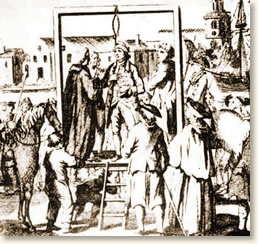|
A London Hanging, 1726
Hanging was the principle method of judicial execution in England from the 1700s until capital punishment was abolished in 1964. Hanging could be the sentence for numerous crimes ranging from burglary to murder. Until 1868, when the procedure was moved in-doors, a hanging was a public event that attracted curious crowds and generated a carnival atmosphere. The intent of this gruesome public display was to deter criminal behavior for all who witnessed it.
Hangings in the London judicial area were usually performed at the village of Tyburn just outside the city on the road to Oxford. Eight "hanging days" were scheduled during the year assuring that the event would involve a number of victims.
A visiting Frenchman reveals his observations of eighteenth century England's judicial system. . .
"Criminals are not executed immediately after their trial, as they are abroad, but are given several days to prepare for death. During that time they may ask for anything that they require either for the soul or for the body. The chaplain of the prison (for there is one) does not leave them, and offers every consolation in his power. The day before the execution those who desire it may receive the sacrament, provided the chaplain thinks that they have sincerely repented and are worthy of it.
On the day of execution the condemned prisoners, wearing a sort of white linen shirt over their clothes and a cap on their heads, are tied two together and placed on carts with their backs to the horses' tails. These carts are guarded and surrounded by constables and other police officers on horseback, each armed with a sort of pike. In this way part of the town is crossed, and Tyburn, which is a good half-mile from the last suburb, is reached, and here stands the gibbet.
One often sees criminals going to their death perfectly unconcerned, others so impenitent that they fill themselves full of liquor and mock at those who are repentant. When all the prisoners arrive at their destination they are to mount on a very wide cart made expressly for the purpose, a cord is passed round their necks and the end fastened to the gibbet, which is not very high.

An Eighteenith Century English Hanging
|
The chaplain who accompanies the condemned men is also on the cart; he makes pray and sings a few verses of the Psalms. Relatives are permitted to mount the cart and take farewell. When the time is up - that is to about a quarter of an hour - the chaplain and relations get off the cart, the executioner covers the eyes and faces of the prisoners with their caps lashes the horses that draw the cart, which slips from under the condemned men's feet, and in this way they remain all hanging together. You often see friends and relations tugging at the hanging men's feet so that they should die quicker not suffer.
The bodies and clothes of the dead belong to the executioner; relatives must, if they wish for them, buy them from him, and unclaimed bodies are sold to surgeons to be dissected. You see most amusing scenes between the people who do not like the bodies to be cut and the messengers the surgeons have sent for bodies; blows are given and returned before they can be got away, and sometimes in the turmoil the bodies are quickly removed and buried.
There is no other form of execution but hanging; it is thought that the taking of life is sufficient punishment for any crime without worse torture. After hanging murderers are, however, punished in a particular fashion. They are first hung on the common gibbet, their bodies are then covered with tallow and fat substances, over this is placed a tarred shirt fastened down with iron bands, and the bodies are hung with chains to the gibbet, which is erected on the spot, or as near as possible to the place, where the crime was committed, and there it hangs till it falls to dust. This is what is called in this country to 'hang in chains'."
References:
This eyewitness account appears in: de Saussure, Cesar, A Foreign View of England in the Reigns of George I and George II (1902), reprinted in: Charles-Edwards, T. and B. Richardson, They Saw it Happen, An Anthology of Eyewitness's Accounts of Events in British History 1689-1897 (1958); Gatrell, V.I.C., The Hanging Tree: Execution and the English People 1770-1868 (1994).
How To Cite This Article:
"A London Hanging, 1726," EyeWitness to History, www.eyewitnesstohistory.com
(2009).
|






